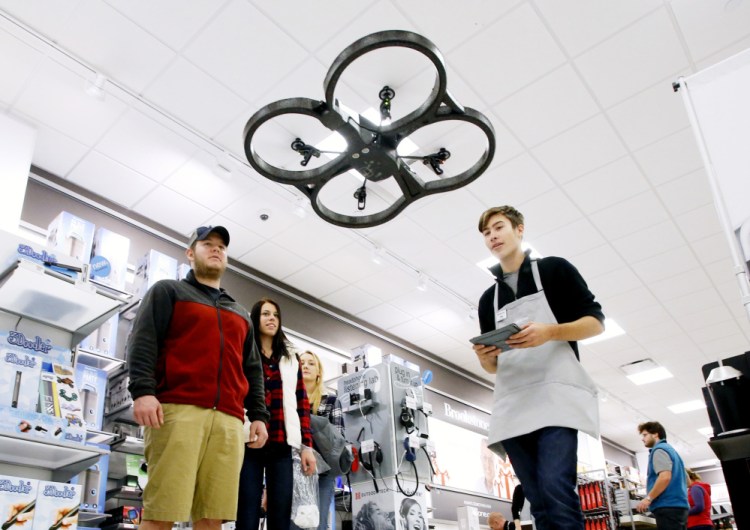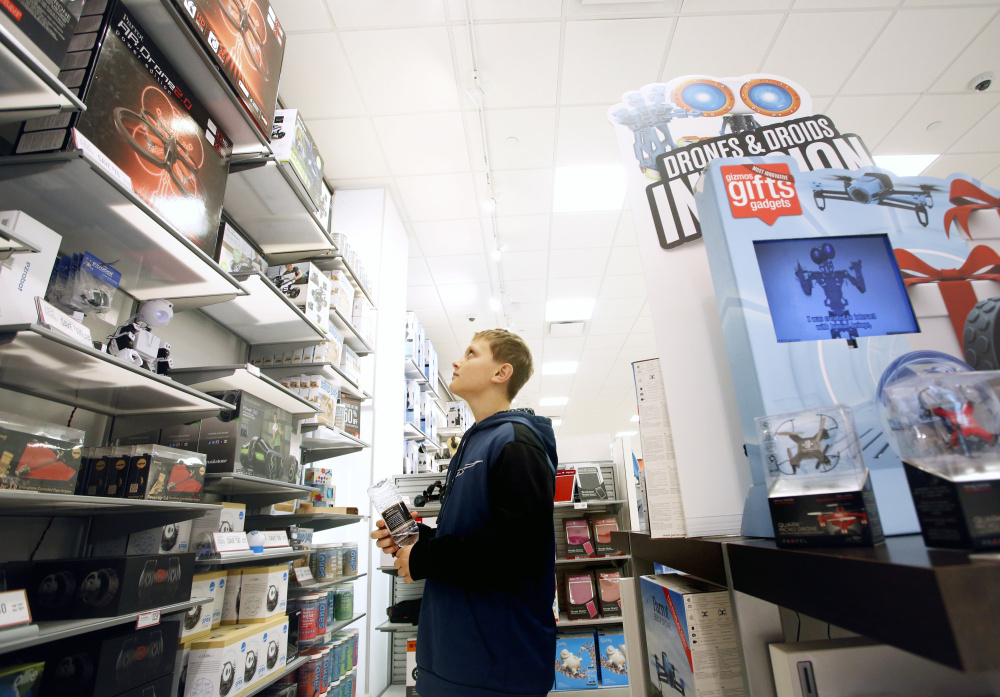SOUTH PORTLAND — A remote-controlled quadcopter hovered over the drone display at the Brookstone store at the Maine Mall on Friday morning. Ten-year-old Jett Wing of Standish gazed longingly at the toy as it darted around the store.
“It’s just like flying,” said Wing, who hopes the Parrot AR Drone will appear under his family’s tree this Christmas.
Wing’s hopes are shared by hundreds of thousands of children – and in many cases their parents as well – as flying drones go mainstream. The Federal Aviation Administration anticipates that as many as a million drones could be sold this holiday season and is preparing new rules aimed at bringing order to the nation’s increasingly crowded airspace.
An FAA task force on Nov. 21 announced a proposal to require hobbyists to register their drones so police can identify the owner if it flies somewhere it’s not supposed to – like the White House or within 5 miles of an airport.
“If something happens, they will be traced,” said Michael Bosse, an attorney at Bernstein Shur, who leads the law firm’s new “drone team,” created to help clients stay informed about emerging legal issues related to drone use.
The proposal by the Unmanned Aircraft Systems Registration Task Force would apply to drones that weigh less than 55 pounds and more than 250 grams.
The registration would be free. The FAA would send a certificate of registration, either by mail or electronically, containing the FAA-issued registration number. The drone pilot would then put that number on every drone he or she operates.
The FAA hopes to have the new rules in place by the end of this year.
The federal government has been slow to respond to the explosive growth of flying drones, some of which are capable of flying more than 2,000 feet in the air. The more expensive drones have video cameras that send live images to operators on the ground, allowing the operators to pilot the drones even when flown beyond their line of sight.
Under current rules, recreational drones must be flown within the operator’s field of vision and below 400 feet. Drones are prohibited from flying within 5 miles of an airport without first obtaining permission from the control tower.
There is growing concern in Congress that drones pose a threat to airliners. During a hearing on drones held last month by a Senate appropriations subcommittee chaired by U.S. Sen. Susan Collin, R-Maine, she said regulators must strike a balance between legitimate uses by responsible drone owners and “dangerous intrusions caused by irresponsible operators.”
Collins said she is particularly worried about “rogue” drones that could interfere with aircraft.
According to the FAA, there were 764 possible encounters with unmanned aircraft reported by pilots or airport personnel from November 2014 to August 2015.
One of those encounters occurred in Maine. On March 24, a radio-controlled helicopter about 8 inches long was found at the intersection of taxiways at the Portland International Jetport, according to the FAA. The drone was sitting upright and facing the runway.
The Consumer Electronics Association says about 700,000 drones are expected to ship in the U.S. this year, 63 percent more than last year.
Many drone manufacturers have reduced prices in the past week, perhaps because they’re eager to reduce their inventories before the new rules go into effect, said Ray Labointe, a former commercial pilot who sells drones in his Falmouth store, Ray & Robin’s Hobby Center,
Labointe shares Collins’ concerns about safety and has been frustrated by the federal government’s slow response to drone regulation. He now worries, though, that the FAA is rushing to make up for lost time and will implement rules that are not carefully considered and will have unintended consequences.
For decades, he said, hobbyists in Maine have flown remote-controlled model airplanes without incident. The planes don’t have cameras on board and must be flown with the operator nearby. But he fears that rules for drones will also affect people who fly model airplanes.
For example, he said, since 1993 hobbyists in a local club have flown their planes at a field near Running Hill Road in Scarborough. The field is about 4 miles from the Portland International Jetport.
Still, implementing a registry for drones won’t pose a threat to model-airplane clubs and is a good idea, Labointe said. “The registry process is a way to help slow down things before they get way out of control,” he said.
Send questions/comments to the editors.




Success. Please wait for the page to reload. If the page does not reload within 5 seconds, please refresh the page.
Enter your email and password to access comments.
Hi, to comment on stories you must . This profile is in addition to your subscription and website login.
Already have a commenting profile? .
Invalid username/password.
Please check your email to confirm and complete your registration.
Only subscribers are eligible to post comments. Please subscribe or login first for digital access. Here’s why.
Use the form below to reset your password. When you've submitted your account email, we will send an email with a reset code.